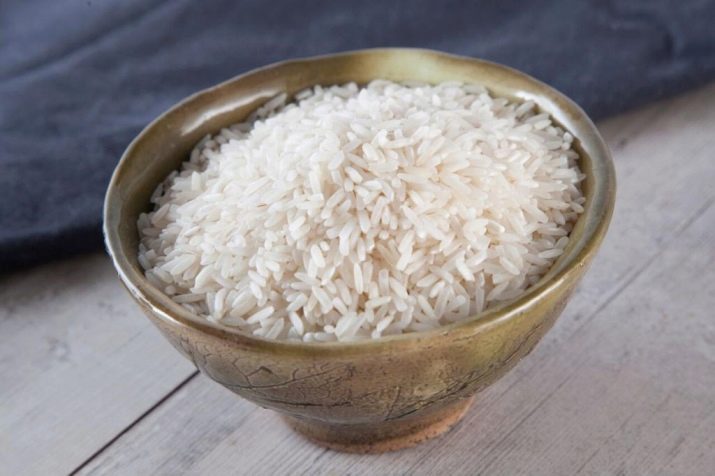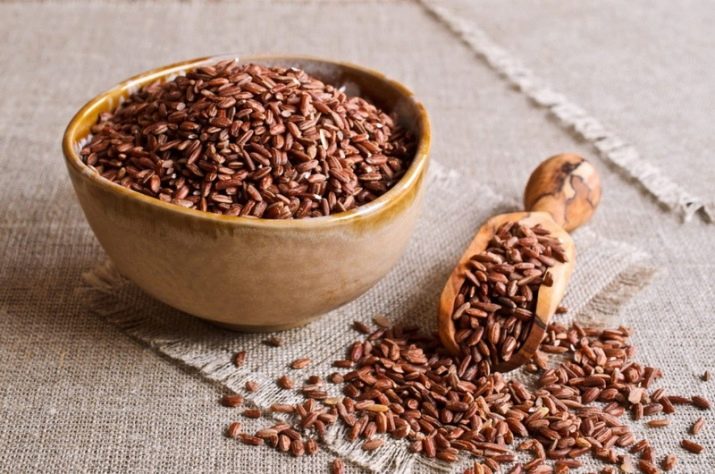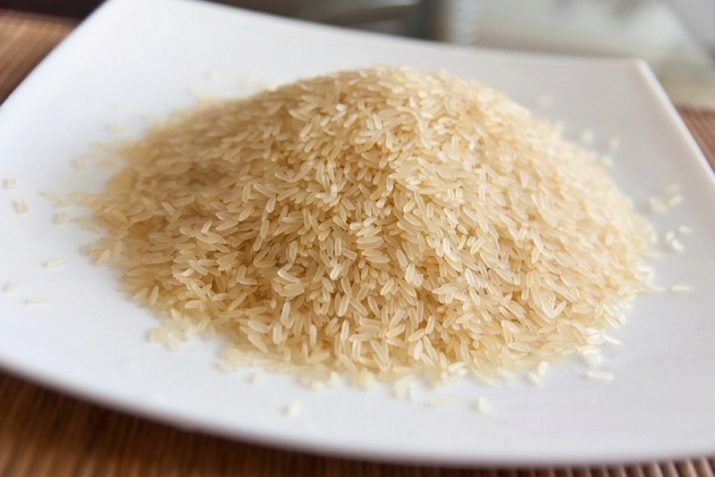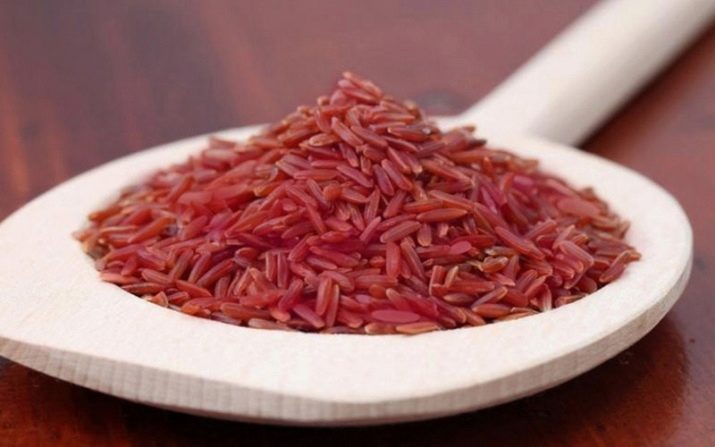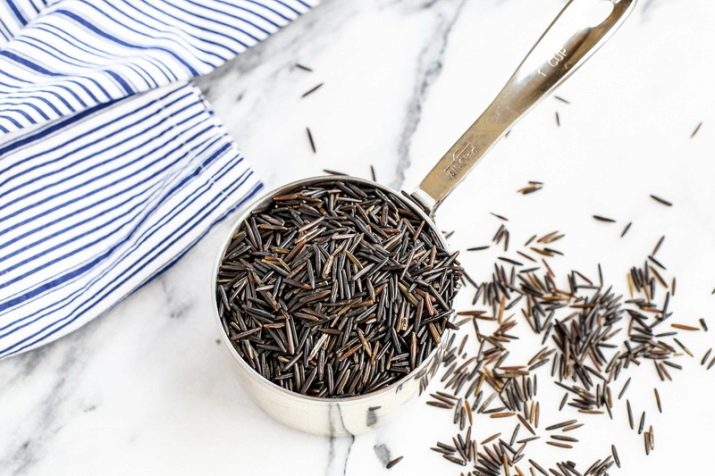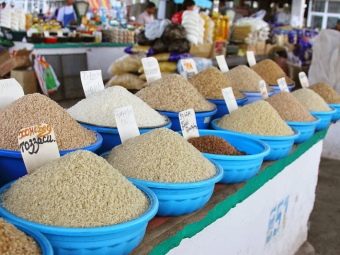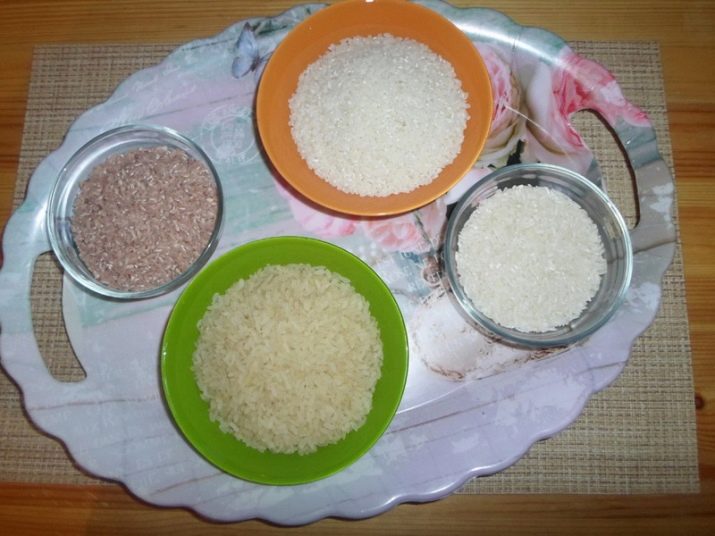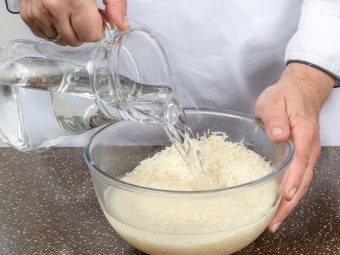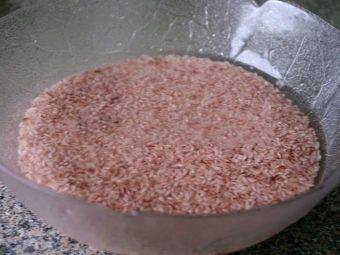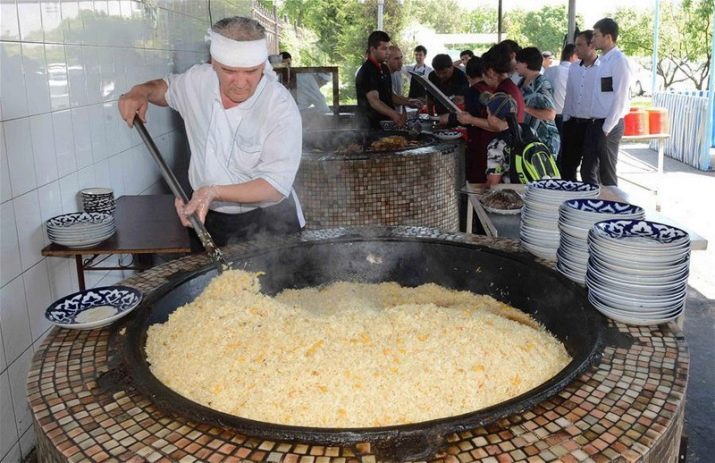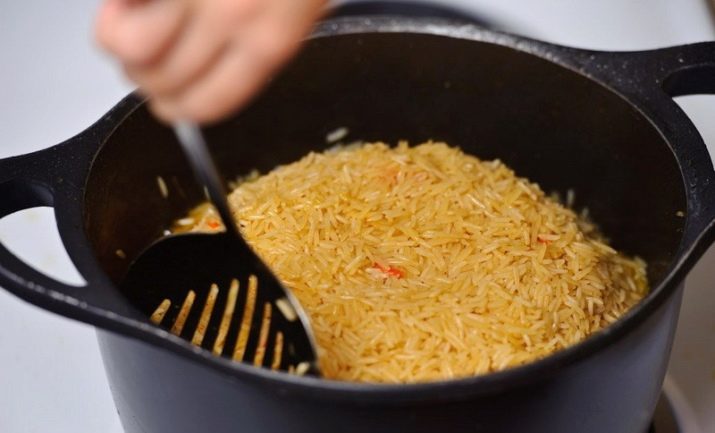Which rice is better to use for pilaf?
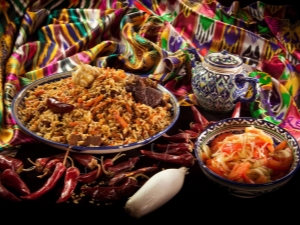
Pilaf is a national dish of the peoples of Asia and the Middle East, a symbol of Oriental hospitality.Crumbly, fragrant, moderately fat pilaf - a real table decoration and joy for gourmets. Its preparation is a real art, and there are no trifles in the process. Responsibly and competently, you need to approach each stage of cooking, including the choice of rice.
Types and varieties
Rice groats have many varieties, each of which is optimal for a particular dish. Classification can be carried out according to a number of criteria:
Type of grain
Long grain
The croup has an oblong shape with a length of up to 8 mm. It is transparent (the highest quality), brown and white. At observance of technology of preparation such rice usually remains friable.
Kruglozerny
Grains are balls with a diameter of about 5 mm. Such rice is white. In the process of cooking glued, and therefore used in cereals, rolls.
Medium
Intermediate option between the varieties described above. Usually it is an oblong white croup with a length of up to 6 mm. Requires a large amount of water when cooking, but even the observance of this condition does not allow getting crumbly rice. It is only possible to bring it closer to the long-grain in terms of friability, almost without boiling up.
By the way (degree) of processing
Brown (brown)
Another name is unpolished. This croup is almost not processed, therefore, retains its outer shell. This, in turn, contributes to the maximum preservation of healing components and makes brown rice the most useful. Low starch content makes this product a dietary one, however, it reduces the shelf life. Brown cereal does not absorb moisture, so some consider ready-made meals from such cereals to be rather dry. In order to save this rice can be mixed with high-quality steamed long-grain analogue.
White (sanded)
It is characterized by a high level of starch in the composition, and after boiling it loses most of the useful elements. However, it is wrong to assume that white rice is not suitable for pilaf. The white shade and the corresponding processing are the varieties "Basmati", "Jasmine", "Arbio", traditionally used for cooking pilau. Krasnodar rice is also white.
Steamed
In its favor, steamed rice is close to brown, which is achieved by transferring important components from the shell directly into the grain. This is possible due to the peculiarities of processing - the grits are washed, soaked, steamed and dried.
Red
Dear, quite rare and useful look. Grains are subjected to minimal processing, retain the shell. The latter is rich in fiber, and grains are famous for their high content of iron, B vitamins and other “usefulness”. Red rice is considered dietary, it is low-calorie. The most famous red rice variety is “Ruby”, which has an unusual shade and subtle walnut amber. You can save all the benefits of red, like brown rice, by baking it in the oven. With this method of cooking there is a minimal destruction of the healing components.
Variety variety
Thai
It is considered expensive, is a long-grain rice, which in the process of cooking is increased by 1.5-2 times. Rich in vitamins and trace elements, has a pleasant nutty aftertaste.
"Jasmine"
We love many housewives, not only for the delicate taste, but also for the fact that rice does not boil soft. This white grits come from Thailand. Characterized by light creamy notes, often acts to replace the more expensive "Basmati". The product received its name due to the delicate and delicate aroma, somewhat similar to the smell of jasmine flowers. Another name is Asian rice, which is associated with the areas of its cultivation - these are the countries of Southeast Asia, Thailand.
"Camolino"
This variety is originally from Egypt. It has a delicate taste and aroma, does not stick together during cooking. Grains are white, medium grain. This is an oiled variety; it is additionally processed with vegetable oils during grinding.
Wild
This variety is grown exclusively in North America, which causes its relatively high cost. It is a brilliant oblong grain and requires a long (40-45 minutes) cooking. The taste is unusual - sweet, with a nutty sound.
"Basmati"
Transparent elongated rice grown in Pakistan (most valuable) and India, at the foot of the Himalayan mountains. But from the purchase of "Basmati" from America is better to give up, it has little in common with Pakistani and Indian counterparts. A feature of the variety is the ability to lengthen during cooking without gluing. The name translates as "fragrant", which exactly corresponds to the truth. Has a high cost.
Indica
Another variety of long-grain rice, which is crumbly during heat treatment - the grains are easily separated from one another and do not have a starchy taste.
Devzira
Uzbek rice variety, grains of which have an oblong shape and are characterized by some ribbing. They are opaque, transparent and covered with silky "powder". After washing and soaking, they increase in volume up to 7 times, and when cooked, they do not stick together or stick together. It is easy to guess that the traditional Uzbek dish is prepared exclusively from this raw material.
"Arborio"
It is a medium grain or round grain rice from Italy. It is characterized by the active absorption of odors, so aromatic pilaf, risotto are obtained from it. It is fair to note that it was originally intended specifically for risotto. However, the structure necessary for the dish can be preserved only by carefully measuring the ratio of rice and liquid and preparing it to the al-dente degree.
"Valencia"
This type is similar in appearance and partly to Arborio. It is traditionally used for making paella - it does not cook into lumps and harmoniously with seafood.
Krasnodar
One of the most affordable and common varieties of rice. It has a medium grain or round grain appearance, medium degree of starchiness. It is considered a universal cereal, which is suitable for cooking cereals, side dishes, pilau, soups. Before laying in the pilaf it is recommended to thoroughly wash and be sure to pre-soak the cereal. This will relieve rice from starch, but still will not allow to achieve authentic taste of pilau.
How to choose?
Pilaf requires special rice. First of all, it should absorb moisture well, increasing in volume. However, it is important that the croup remains crumbly, not stick together. Ideal - "Devzira", "Basmati" or "Jasmine." If these varieties were not at hand, the usual long-grain or steamed rice will do. The Uzbek varieties are optimal, they are distinguished by an oblong shape and transparency. Those can be called rice "Dastar-cheese". Before threshing, grains from it are kept for several years, periodically watering with rice water. As a result, rice acquires an amber shade, and in the process of cooking it absorbs oil, vegetable juices, but does not boil soft.
From the use of finer white cereal should be abandoned - from it never cook crumbly dish. An exception may be, perhaps, white rice "Lazarus". Its feature is the ability to absorb a lot of liquid (due to starch), without boiling loose. The result is a tasty and close to the original recipe Bukhara, Tashkent or Harez pilaf. It is better to purchase rice in specialized stores or on the market.
The raw material should be inspected - it should be the same size and uniform in color. The latter should resemble a frosted glass.
If there are stains, a lot of dust and broken grains on the surface of the grains, this indicates a low-grade product. White blotches are fragile unripe grains that will negatively affect the taste of pilaf.Yellowish grains, including the yellow cut of the grain, indicate that the risk was stored incorrectly before packaging, so it was soaked. After evaluating the grain visually, it is necessary to conduct their tactile testing. To do this, dial a handful of rice and squeeze it hard in your hand. If the products are of high quality, a characteristic dry crackling will be heard. After you open the fist, you should not see broken or damaged pips.
Now came the turn to taste the cereal. You need to try to grasp the grain, if it can be done easily enough, you should refrain from buying if you want the finished pilaf to crumble. A dish of such grains will turn out to be starchy and will rather resemble porridge, and not pilaf. Having decided on a suitable type of cereal, it should be properly prepared (this will be discussed below), and also to determine the ratio of raw materials and liquids. This proportion also largely determines the consistency of the dish.
If you are purchasing packaged products, choose a container through which you can consider the characteristics of the composition. Here the criteria are the same - rice should have the same fraction, shade, do not contain dust and impurities, grain fragments. Interestingly, dishes from different nations suggest a different ratio of rice and water. So, for Uzbek plov, these ingredients should be taken in equal parts. It is understood that the rice is washed and soaked in water beforehand. If you ignore this recommendation, then the rice will be too much and it will burn. In Azerbaijan's pilaf, where the components are prepared separately and only at the end of cooking, they mix, 3 glasses of water are taken for a glass of rice.
When choosing a particular type of rice, you should consider what kind of pilaf will be cooked. So, for the Indian dish is better "Basmati". It may include chicken, be sure to add not only vegetables, but also dates, ginger, cashews, nuts. In Tashkent Tashkent pilaf usually put long rice, for example "Lazar". Since a lot of fatty meat is put in the dish, it is better to choose rice varieties that absorb fat and oil well. Long grain rice is used in Samarkand. In Kyrgyzstan, pilau is cooked exclusively from Devzira, since it is grown in this region (Fergana Valley).
For cooking in a cauldron on the fire
Traditional oriental rice is cooked in a cauldron on fire. For such recipes, you need to take rice varieties that absorb oil and vegetable juices well, while remaining crumbly. Then the dish will have not only a suitable structure, but it will also turn out to be fragrant, rich in taste. In a good swim, the taste of the individual components should not be felt, they should penetrate each other, as if merged into a single sound. This is achieved, of course, by adherence to cooking technology and in many respects by correctly selected rice.
For these purposes, ideal "Devzira", "Basmati", "Jasmine", "Arborio", and wild rice will do. Red and brown rice will also be an excellent basis for real pilaf, but finding them on the shelves of domestic stores is not an easy task. For cooking on a fire in a cauldron, Thai Passim or another high-quality steamed variety will be an excellent grade.
For multicooker
Since in the multicooker it is assumed hermetic closing of the bowl during cooking, the level of humidity in the pot increases. This imposes certain features on the choice of rice for pilaf - the grains must absorb a lot of water without sticking to it. It copes well with this task "Jasmine", "Indica", "Arborio". Devzira and Super Basmati will do. Before placing the cereal in the bowl of the device, it should also be thoroughly washed and soaked in water. The optimal program is the same name "Plov".
Do I need to wash rice?
It is not enough to choose the right cereal to get tasty pilaf. It is also necessary to properly handle the grain. Washing the rice helps to reduce the chance of their sticking.This is required if you want to get a crumbly dish. Rinse the grits in hot water, changing the water 3-5 times. It is recommended to stop this procedure only after the water is not completely transparent. Professionals often add a little turmeric to the water for the last wash. This gives the raw material a pleasant yellowish tint and subtle spicy aroma.
Next, you need to fill the grits with filtered (settled), boiled or clean bottled water and leave for at least an hour. “Devziru” and “Samarkand”, as well as specialized varieties of Uzbek rice are best soaked for 2-3 hours. Rice will absorb moisture and will not increase too much in volume. It also affects the stickiness of the grain. A lot of liquids are required - about 600-650 ml of water per 150 g of grains. When soaking, you can put some salt and spices in the water, this will make the raw material more fragrant.
The important point - steamed rice should only be washed with water, soaking it is not necessary. Otherwise, the raw material will become brittle and brittle, which is not the best way to affect the taste of the finished dish. Before laying the rice, it is necessary to drain water from it well. The heating temperature of the dish should not be raised more than 80 degrees.
Reviews
Reviews show that even unspecialized long grain or steamed rice can be made much more crumbly if you wash it at least 3-4 times. A big mistake is the opinion that steamed rice is cooked quickly. In fact, it takes 30-40 minutes. Today, more and more manufacturers label their products as “rice for pilaf”, “rice for porridge”, etc. This greatly simplifies the selection procedure for the buyer. However, true professionals and gourmets still prefer to pick the grain themselves. However, ready mixes also have quite good responses.
For example, rice "For pilaf" from TM "National", according to reviews, does not stick together, does not boil soft. It is also suitable for side dishes, risotto. Among the advantages and affordability. Some housewives believe that from almost any kind of rice can be cooked delicious pilaf. The main thing is to process it correctly. A common method of washing, soaking, drying and then lightly roasting cereals in a hot dry frying pan. Thus, it is possible even to turn inexpensive rice varieties into exclusive raw materials for pilaf.
Experienced hostesses prefer to buy all the ingredients for Uzbek pilaf on the market directly from the Uzbeks themselves. This applies not only rice, but also spices. Likewise, you rarely have to deal with the fact of low-grade low-quality raw materials, and useful cooking recommendations will not be redundant.
Professionals believe that Devzira is the most suitable variety for Uzbek pilaf. Grains not only remain crumbly, but well absorb oil and fat, while acquiring a special velvety. "Jasmine" and "Basmati" can replace it, but the taste, like the appearance of the dish, will differ from the traditional recipe. This pilaf (and very useful) can be obtained from brown rice. However, its taste is quite specific, many say that you need to get used to it.
How to choose rice for pilaf, see the next video.



